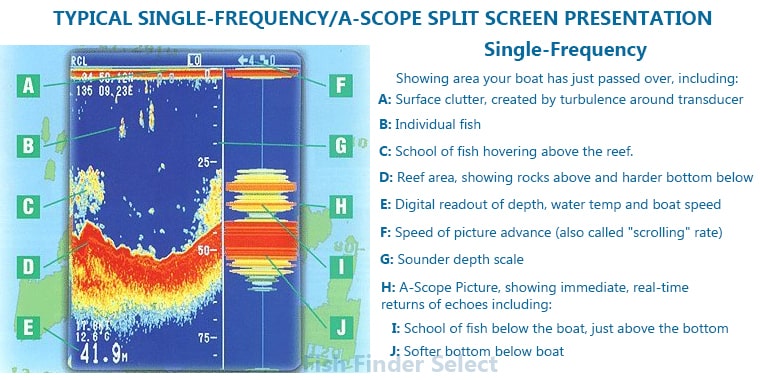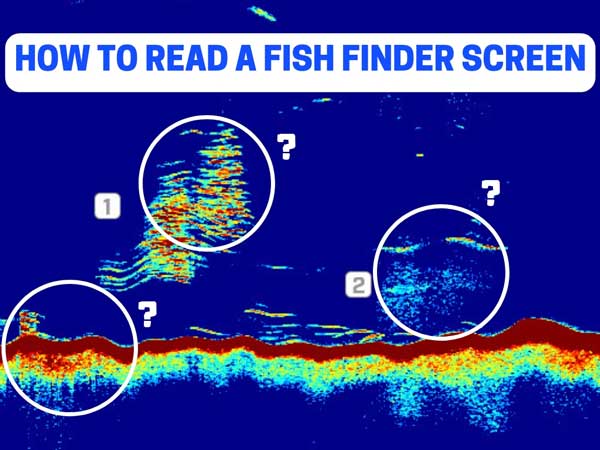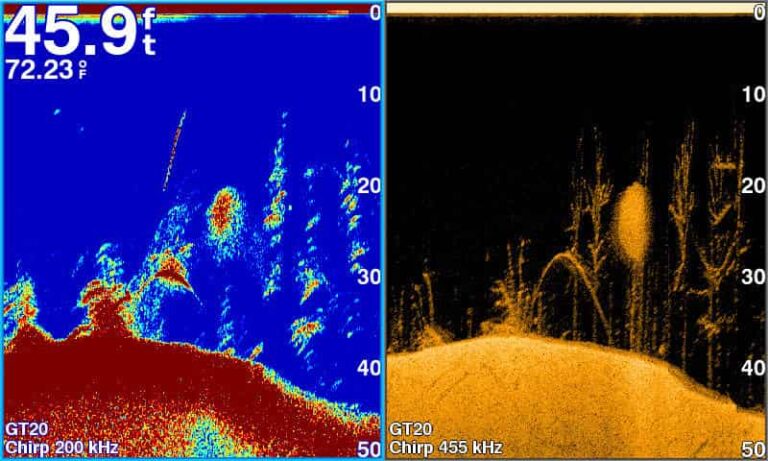Table of Contents
Toggle
If you’ve ever wondered where those elusive fish are hiding, fish finders are the answer!
In this article, we’ll guide you through the secrets of reading a fish finder like a pro.
From interpreting sonar data to decoding bottom structures, get ready to level up your fishing game. Let’s dive in and make those epic catches!

Sonar Graph: The heart of the fish finder display is the sonar graph, which shows real-time sonar readings. It represents the underwater landscape and any objects or fish detected. Sonar graphs can be displayed in various ways, such as scrolling horizontally or vertically.
Fish Icons: Many fish finders have a feature that automatically identifies fish and displays them as fish icons on the screen. These icons vary in size and shape based on the strength of the sonar return. While convenient, it’s essential to learn how to read raw sonar data for more accurate fish identification.
Depth Indicator: This component indicates the depth of the water beneath your boat. It’s typically displayed numerically, and some fish finders use colors or shading to represent different depth ranges.
Water Temperature: The water temperature reading shows the temperature of the water at your current location. It can be vital in locating fish, as different species have preferred temperature ranges.
Bottom Composition: The fish finder may show the type of bottom composition, such as rocks, mud, sand, or vegetation. Understanding the bottom structure can help you find potential fish-holding areas.
Zoom Function: Fish finders often come with a zoom feature that allows you to magnify a specific section of the sonar graph. This is useful for focusing on the depth range where you expect to find fish.
Gain and Sensitivity Controls: These settings allow you to adjust the fish finder’s sensitivity to better detect fish and underwater structures. Properly tuning these controls ensures a clear and accurate display.
GPS Navigation: Some advanced fish finders come with built-in GPS functionality, displaying your boat’s position on a map. This feature helps you mark waypoints, track your fishing routes, and return to productive spots.
Split-Screen View: Many fish finders offer a split-screen mode, allowing you to view multiple functions simultaneously. For example, you can see the sonar graph alongside GPS navigation or a zoomed-in section.
Also Read: Best Fish Finder for the Money

CHIRP Sonar:
DownScan Imaging:
SideScan Imaging:
StructureScan:
Understanding sonar images is like deciphering a secret language of the underwater world. When you glance at the sonar graph on your fish finder, it may seem like a bunch of colorful lines and shapes, but fear not! Let’s demystify these images and uncover what they represent:
Echoes and Reflections:
Fish Arches:
Suspended Fish:
Bottom Structure and Composition:
Baitfish and Predator Fish Patterns:
Thermoclines:
Remember, interpreting sonar images may take some practice and experience, but with time, you’ll become proficient in identifying fish, structures, and other underwater elements.
Pay attention to the context of the area you’re fishing in, and soon you’ll be reading sonar like a pro and enhancing your fishing success.
Identifying fish arches, suspended fish, and structures on your fish finder is like being a detective in the underwater world. Let’s dive into how to spot these important elements and what they mean for your fishing success:
Understanding water depth and temperature is crucial for successful fishing. Water depth determines fish positioning, while water temperature influences their activity levels.
By interpreting these readings on your fish finder, you can target the right areas and adjust your approach for better fishing results.
Understanding Depth Units:
Depth Scale and Range:
Depth Lines and Contours:
Depth Variations and Drop-offs:
Vertical Jigging and Presentations:
Shallow Areas and Weeds:
Thermoclines and Temperature Layers:
Tracking Depth Changes:
Reading bottom composition and structure is like deciphering the underwater landscape, revealing where fish love to hide. Here’s how to do it:
Identify Bottom Composition:
Spot Underwater Structures:
Watch for Drop-offs and Ledges:
Identify Vegetation and Weeds:
Combine Data for Targeting Fish:
Create Waypoints:

For seasoned anglers looking to take their fish finder interpretation to the next level, here are some advanced tips to fine-tune your fishing game:
Study Fish Behavior and Habitat:
Master Sonar Sensitivity Settings:
Combine Multiple Sonar Technologies:
Fine-Tune Depth Range and Zoom:
Track Fish Movements:
Use GPS Waypoints Strategically:
Learn from Past Trips:
Stay Updated with Technology:
Stay Open to Learning:
By honing your fish finder interpretation skills and combining them with a deep understanding of fish behavior, you’ll become a true fishing maestro.
Embrace the adventure, and let your fish finder be your trusted partner in uncovering the mysteries of the underwater world.
Now that you know how to read a fish finder, you’re ready to dive into the underwater world and reel in more catches than ever!
Remember, practice makes perfect, so keep honing your skills and enjoying the fishing adventure. Tight lines and happy fishing!
